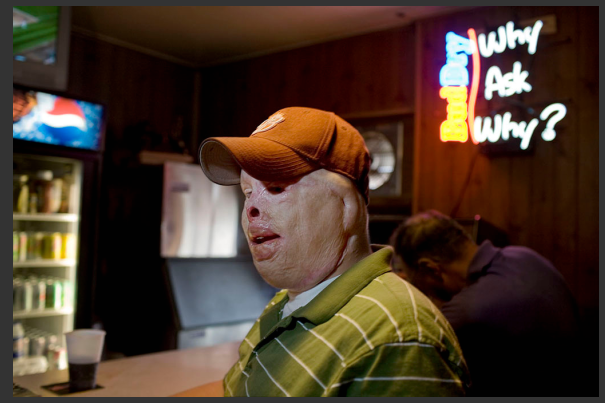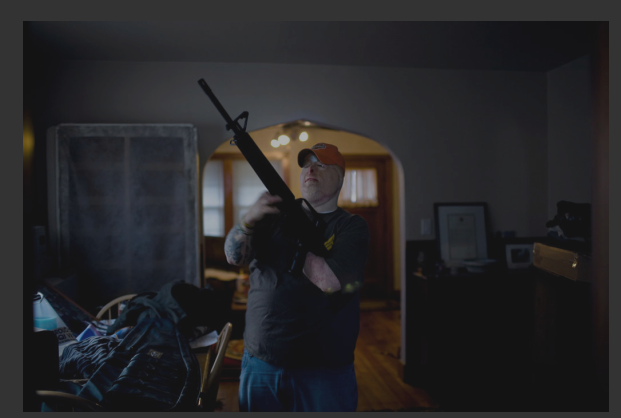Serendip is an independent site partnering with faculty at multiple colleges and universities around the world. Happy exploring!
Inter-acting with Art, Nina Berman's "marine wedding"

Lee Wacker
10/1/11
PPPPP Gen/Sex
Webpaper 1
I choose to explore my current understanding of en-abling the intra-action of gender, sexuality, and disability by looking at a series of images done by photographic artist, Nina Berman. I actually saw this photo series in New York City in 2010 at the Whitney Museum of American Art’s 2010 Whitney Biennial.
Before I entered into the exhibit space for, marine wedding, there was a warning sign, largely printed and strategically placed for viewers to take note of. The sign foretold of graphic, violent and disturbing imagery. I ignored the sign and forged ahead into the room. There were very few people examining these images. Other rooms in The Whitney were packing with visitors for the Biennial’s hot young artists and eye-catching displays but this room was near vacant. I entered the room with my mom and found that almost immediately she decided she didn’t want to look at these images. There was something about the nature of these images that discomforted her enough to leave the room.
In this paper I would like to go back to the 2010 Whitney Biennial and critically re-examine the visibly highlighted intersections of gender, sexuality and disability in this series. Although I will not return to the space of the museum as a forum for fostering dialogue and discussion over issues of representation I think it important to note that (after my conference with Kaye) that the space of the museum can be a much more liberating and indeed liberal environment for pictorial representation than that of other arts or media outlets. Here I am referencing the refusal of the press to publish images of flag draped coffins returning from Afghanistan and Iraq. I have attached the below National Public Radio article for contextual reference in the interest of making the webpaper as accessible and inter-active as possible.
[http://www.npr.org/templates/story/story.php?storyId=101137468]
Eli Clare, author of Exile and Pride, wrote this leading question in the Preface to his book, “Who gets killed, and who becomes disabled? Who profits from that killing and disabling? Whose bodies are used as weapons, and whose are treated as expendable?” (Exile and Pride, xiii). My paper is not going to discuss the politics of Clare’s “who,” those who have created institutions and opportunities for killing, violence and the disabling of individuals.
However, I would like to further explore how within the photo series, marine wedding, photographer Nina Berman is responding to Clare’s question by visually disturbing traditional representations of normative masculinity, heroics and ability. Berman isn’t establishing her subject, Marine Sgt. Ty Ziegel as anything more or less than what is written in the brief biography of him, which is included along with the pictures of him and his family. The viewer is left to inscribe and ascribe meaning onto and into the images as they see fit.

(Figure 1, http://www.ninaberman.com/marine_wedding)
When I viewed this exhibit in person I don’t remember there being any placards next to the photographs. Just as online, if one visits Berman’s site and looks at the virtual exhibition of marine wedding there are no titles, explanations or artist’s statements to guide the viewer through the work. All that we have as viewers is what we come with. Clare states in the preface that all of our answers are dependant upon, “naming disability and committing to a multi-layered analysis” (Exile and Pride xiii). But Berman starts her online slideshow with an image of Ty in the foreground, framed by a neon advertisement behind him stating, “Why Ask Why? Grounding this series in a question about asking questions is a testament to the notion of entanglement and the difficulty of unpacking the distinct connectedness of disability, gender and sexuality. Echoing Clare’s statement that, “Disability snarls into gender. Class wraps around race. Sexuality strains against abuse” (Exile and Pride 159).

(Figure 2, http://www.ninaberman.com/marine_wedding)
These images of Ty do not erase the masculine from a disabled body nor do they highlight the ability of a disabled body. They present a subject who has multiple and overlapping subjectivities being presented. We know Ty as a marine, as a married man, as a divorced man, as an enabled disabled man and as a veteran. These images present visual constructions of what masculinities are and can be. But how can we know if this is the masculinity that Ty feels and wants to present? When I first starting thinking about this paper I was drawn to this series in an interest of discussing its representation of the “super-crip” that Clare vehemently opposes. I wanted to challenge how this series presents images of a man who may have physically survived a suicide bombing attack but emotionally seems dead. I wanted to discuss the limits of the “super-crip” model and how it could possibly be an enabling trope within the veteran and military community. Instead
I veered my thoughts and reflections towards representations of masculinity and performance of gender. I thought that looking at images of a (dis)abled veteran, within a military community that has culturally normalized extreme hetero-normativity and excess masculinity, would enable me as a viewer to understand how Ty and many other veterans are dealing with identity politics today. Figure 3 shows Ty in the domestic sphere, placed in a room with little to demarcate it. Ty is positioned in the middle of the room and is show holding what I assume is an automatic rifle.

(Figure 3 , http://www.ninaberman.com/marine_wedding)
This is weapon Ty probably carried while on active duty and it is an object that civilians use to identity those individuals who serve in the armed forces. It is an object of status that denotes position and importance but it is also an object made to be used in acts of violence. This is an object that is not associated with disabled people since disabled people are not associated with the armed forces. This is an object not associated with people whose masculinity has been effaced as Ty’s has. Although it is clear to the viewer that Ty has the body of a man his physiognomy has been so badly burned from the accident he was in that his facial markers are no longer available to us to detect signs of gender. And so Berman and Ty, or just TY, or maybe only Berman as the artist of the series wrote in this automatic rifle as a disavowal of Ty’s absent masculinity and disability from the image.
Riki Wilchin’s argues that we must, “deconstruct someone’s docile body or the dressage of gender they live in… engaging how that feels for him or her” (Queer Theory, Gender Theory 105) but this project cannot be done for Ty (at least not through this series of images). We as viewers can engage in the deconstruction of Berman’s photographs by asking critical questions and addressing the visual language used to present Ty’s subjectivity. We can address, as Clare prompted, the deconstruction of institutions, namely the military that were responsible for creating some of the identities Ty is now inscribed with visually. But, we cannot fully understand the nature of these images and the masculinities they present because we cannot know if their subject has had agency in creating these projections of self.
Works Cited
Berman, Nina. "marine wedding." Nina Berman Photography. Nina Berman, 2011. Web.
2 Oct. 2011. <http://www.ninaberman.com/>.
Clare, Eli. Exile & Pride: Disability, Queerness and Liberation. Brooklyn: South End Press, 2009.
Wilchins, Riki. Queer Theory, Gender Theory An Instant Primer. Los Angeles:
Alyson , 2004. Print.



Comments
a different way to be married?
The powerful imagery in Nina Berman's exhibit, "Marine Wedding," has provided you with a strong platform to grapple with several entangled themes—masculinity, disability, war, marriage, visual representation. As you note, Berman’s photographs of Ty profoundly unsettle our culturally normative representations of masculinity as being married to a woman and serving in the military. It also raises the question of whether disability trumps gender. (See also week 4 notes on the potential hierarchical relationship between disability and gender.) You highlight that Berman’s exhibit does not function as a "super-crip" visual narrative of a Marine, who, although severely injured in Iraq, marries his home-town sweetheart and happily resumes his life. For, even when decked out in his military uniform for the wedding, the images portray profound disconnects between cultural ideals, physical realities, and human relationships. By following the link to the exhibit, we see pictures of a prosthetic arm on the hood of a car, of a bride looking away and in shock, of Ty holding a machine gun in the house.
You productively highlight how the introductory text for the exhibit and the pictures themselves reveal to a certain extent Ty’s "multiple and overlapping subjectivities (…) as a marine, as a married man, as a divorced man, as an enabled disabled man and as a veteran" I’d like to add that they also represent his social positions and relationships—here is someone who goes to bars, who participates in public rituals, who is a son, who drives a car, who is looked at quizzically by a child in the grocery store—all of which intra-act to create his life. Yet, you challenge what this exhibit actually says about the subject’s concept of masculinity by asking whether Ty had any agency in how he was posed or in the selection of pictures for the exhibit? Do these photos only allow us to unpack the artist’s perspectives on masculinity, the military, and marriage?
I found the quotes you chose from Eli Clare’s book to be particularly powerful and resonant with the images: “Who gets killed, and who becomes disabled? Who profits from that killing and disabling? Whose bodies are used as weapons, and whose are treated as expendable?” and with your analysis: “Disability snarls into gender. Class wraps around race. Sexuality strains against abuse”
I do wish you had spent more time elaborating the intra-actions of the war, disability, and masculinity rather than telling us what you are "not going to" do: “…discuss the politics of Clare’s ‘who,’ those who have created institutions and opportunities for killing, violence and the disabling of individuals” nor “…return to the space of the museum as a forum for fostering dialogue and discussion over issues of representation” nor “…discuss the limits of the “super-crip” model and how it could possibly be an enabling trope within the veteran and military community.”
On another entangled note—your posting reminded me of the caption to on the second image on our syllabus: “Quantum Entanglement. A New Way to Be Married.”